
The lumbar spine is most susceptible to tension, as it is affected by the total body weight. Furthermore, it's very portable.
If the corset is not fully developed, the pressure on the disc will multiply. Specifically, they are responsible for the mobility and flexibility of the back.
So low back bone necrosis disease, which occurs for many reasons, is a fairly common disease of the musculoskeletal system.
It develops gradually and a person may simply not notice its first signs. However, it needs serious treatment.
How the disease develops and its causes
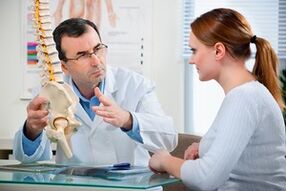
In the lower back, the sacrum and thoracic vertebra are connected. There are many factors that cause lumbar necrosis. The main thing is considered inaccurate and overload in the back.
During the disease, glycoprotein is broken down, affecting the connective tissue of the joint and making it elastic. It affects the bone and cartilage structure of the spine.
The discs contain a gel-like substance that dries out with lumbar disease. They get depleted, then they become flat. As a result, the spine loses its function to lose weight, its segments close together, and nerve roots and blood vessels become clamped.
At the same time, the ring of fibers is cracked, and in some cases may rupture resulting in the formation of a herniated mass. All this causes swelling, lower back pain.
The muscular framework protects the spine from negative influences and is responsible for the correct posture. Problems with him can also lead to the development of osteonecrosis in the lumbar spine.
There are other reasons for the onset of the disease:
- Congenital changes, loose disc structure.
- Strain.
- Infectious diseases of bone and cartilage tissues.
- Wearing shoes is inconvenient.
- Backache.
- Inflammation of the joints.
Here, lifestyle, profession, age are also important. Maximum load on the spine occurs in a sitting position. Therefore, people who spend most of their time in the sitting position are at risk.
These can be office workers, drivers. Little physical activity is also not the best way to affect the lumbar spine. As a result, the musculoskeletal system becomes weaker.
Impact on the spine and especially the lower back, lifting weights plays an important role. The reason is due to occupations such as handlers, construction workers, waiters or professional athletes, who often experience back stress.
Osteochondrosis can also occur during pregnancy in women. If a scoliosis is present, then the pressure on the lumbar spine increases and the uneven weight distribution also leads to disease.
Similarly, it affects the appearance of bone necrosis and flat feet. The arch loses function, and all walking load goes to the spine. Excess weight also plays a negative role. The disease can be complicated after osteomyelitis, bone tuberculosis.
Adverse factors in lumbar necrosis are also improper sleep, nutrition, metabolic disorders in the body or diseases of the internal organs:
- digestive tract and liver;
- small pelvis;
- central nervous system.
People of different ages are susceptible to disease.
Symptoms of lumbar necrosis

One of the first symptoms is usually pain and discomfort in the lumbar spine. At the same time, it may be difficult to bend, back, or break a big toe. Sometimes there is a cold feeling, or vice versa, there is a burning sensation in the back.
As a rule, symptoms appear after exertion, hypothermia or in an uncomfortable position for a long time. They usually go away after a short period of rest. During the acute phase, they may be characterized by low back pain and exacerbated by movements, coughing, and sneezing.
Muscle contractions in the back that do not give the patient posture will lead to increased pain, which happens reflexively. In addition to these symptoms, there are the following signs:
- Fatigue and weakness.
- Sweating increased.
- Sleep disorders.
- Varicose veins.
- Tingling and aching sensations in the extremities.
- Violation of tendon reflexes.
Due to spasms, the legs can become frozen, as well as beak-like growth and a decrease in the height of the disc.
The sciatic nerve, which is formed by the sacral roots of the spinal cord, can also experience bone necrosis in the lower back. This is manifested by pain spreading down the leg or swelling.
If the artery or artery is compressed, this is characterized by loss of sensitivity, but mild pain. They are localized in the lower back, meeting the hips and buttocks. The pain syndrome also has a different time to appear. Painful sensations usually appear in the morning, over time they can become permanent and independent of movement.
Complications of necrosis of the lumbar spine
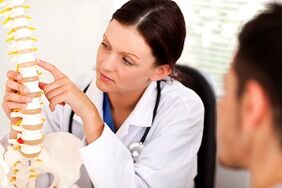
The instability of the discs and their inability to fix the spine leads to displacement of the lumbar spine. This also affects the work of internal organs. Osteoporosis is complicated by problems in the genitourinary system, discomfort in the kidneys.
In women, irregular menstruation can happen with it, in men, problems in the genital area. Another symptom of the disease is flaky and dry skin in the affected areas.
If not completely treated, bone necrosis disease can lead to spinal stroke and other unpleasant consequences. Protrusion of the disc can occur when they extend and extend beyond the boundaries of the vertebrae. Cartilage atrophy is also present. During this stage, the pain may subside due to the growth of bone tissue.
Degenerative spondylolisthesis is sometimes isolated as a form of osteonecrosis, but is often considered a complication of it. With it, a spine-like growth is formed on the spine. They are localized, painful in the lower back and do not spread to other parts of the body.
Another consequence is paralysis of the feet. In the lower back arose unpleasant sensations, spreading down to the area below the knee and furthermore causing dysfunction of the ankle joint. All of these can contribute to a disability.
Diagnosis of osteonecrosis of the lumbar spine
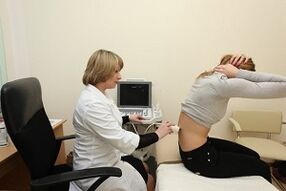
There are several types of studies that your doctor may prescribe for symptoms of lumbar necrosis:
- Simple x-ray (spondylography), showing the status of each individual vertebra, disc and canal.
- Myelography is a more complex type of diagnosis. To do it, a colored liquid is injected into the spinal canal. It helps to find a hernia of the spine.
- A similar procedure is to scan the disc, but with it, the liquid is injected into the spinal disc.
- Chest scan. Here, air is used instead of liquid.
Computer tomography can detect nerve root compression, cutting disc contour. For more severe cases, an MRI may be ordered.
The methods of treating the disease

The main thing is punctual consultation with a doctor and serious treatment. In order to recover, you need efforts, and to prevent relapses need to participate in prevention. Lumbar therapy is a holistic approach. Here, the aim is not only to prevent the development of the disease and alleviate the symptoms, but also to return the spine to its original position.
Specialists often prescribe drugs using pain relievers and anti-inflammatory drugs: NSAIDs, pain relievers. Muscle relaxants are also used. They are aimed at eliminating the spasms and discomfort that arise from increased muscle tone.
Vasodilators prevent congestion and improve blood circulation. Vitamins and minerals give strength to bones, ligaments and tendons and help remove fluids from the body. They are usually prescribed for the elderly.
Chondroprotectors are also used to treat, stop the destruction of cartilage tissue and help with regeneration. The drug is administered orally, injected or rectally.
The vertebral block is used for rapid pain relief when the drug is injected into the affected area. But doctors try not to use them as often. The body gradually gets used to them and its effectiveness decreases. In addition, with a blockade, the muscles may atrophy at the injection site.
The complexity of treatment also includes exercise therapy. It improves the mobility of the spine and strengthens its muscles. Therapeutic exercises should be selected by the therapist, usually prescribed after the acute condition has subsided. The load is gradually increased so as not to cause an exacerbation. Also, exercise utensils if the patient wears bra for long periods of time.
An important part of treatment is massage. It is aimed at relaxation, pain relief and spasm. The procedure reduces muscle stiffness and has a good effect on lymphatic circulation in the tissues around the lumbar region.
Physiotherapy treatments are also used. To get the desired effect, they must be done on a regular basis. Exposure to ultraviolet rays, eliminate spasm, pain affecting blood circulation. Laser therapy helps to improve the condition of the spinal roots due to the effects of a helium-neon emitting substance. Spinal stretching is also used, as well as the following methods:
- amplipulse;
- phonophoresis;
- diadynamic currents.
However, physiotherapy also has contraindications - these are oncological diseases, diseases of the central nervous system. The main task of all these measures is to bring the lumbar spine back to the correct anatomical position. As a rule, the course takes an average of 2 - 3 months, but it all depends on each specific case.
Operations for the treatment of bone necrosis of the lower back
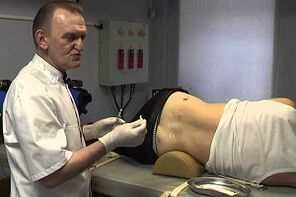
Most often, surgery is used for complications, such as a hernia. Discarding is performed, that is, the damaged disc is removed. Microsurgery and endoscopy cause less trauma to the patient and the risk of complications is minimal.
During such an intervention, special small diameter tube extensions are used. Therefore, muscles and ligaments are not damaged. On average, the procedure takes about an hour.
Rehabilitation takes less time after surgical removal. But here, the patient's support is important, the patient must strictly adhere to all prescriptions of the neurosurgeon.
Additional preventive and treatment measures

Adjusting your lifestyle and habits is the first step in treating degenerative spondylosis. Relaxation and lightness are important in therapy. It is better to equip a bed with an orthopedic mattress and pillow, it is better to put a special roller under the neck. Avoid lying down for a long time will lead to hypothermia. Unwanted to get up suddenly.
Sometimes a special set of corsets is recommended. It keeps your back in place, but not all experts approve of its long-lasting wear. This can lead to muscle atrophy in the spine. Most often it is used during exacerbations of the disease. Bra models are not common and in all cases, only a doctor should choose an accessory.
Along with the treatment, it is important to follow certain measures your doctor may recommend. This is the normalization of weight, the right nutrition is helpful here. It is better to eliminate heavy and fatty foods from your diet or reduce your intake.
Patients with lumbar spondylolisthesis should refuse the following products:
- Soft drink.
- Salt and sugar.
- Coffee and spices.
- Alcohol.
Good to include in the diet: sea fish, vegetable oils, dairy products, vegetables, fruits and herbs. Meat with jelly or jelly, including gelatin, will be very helpful. It is best to steam the food thoroughly.
Walking, swimming is also great for the spine, which will be very helpful for monitoring your posture. These are necessary measures after the end of a course of treatment to prevent recurrence of osteonecrosis.
Folk remedies and alternative methods
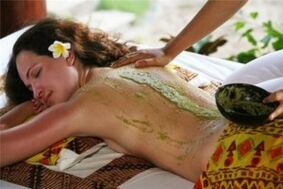
Ointments and compresses are made from plant materials to relieve pain and inflammation. Usually used to crush red chili tincture. Liquid ointment can be made from mustard powder, camphor wine and egg whites. It is applied at night.
They make compresses with honey and aloe or cabbage leaves, use for this and the decoction of burdock leaves. Bathing with needles is very helpful.
There are also alternative treatment options:
- hirudotherapy (using leeches);
- manual and vacuum therapy;
- Acupuncture.
All of these funds are best used after consulting with the attending physician.
Buying medication on your own or ignoring symptoms of lumbar spondylolisthesis can lead to more serious spinal problems. Therefore, you should not start the disease, as the earlier you start treatment, the quicker and easier the problem is to resolve.

























